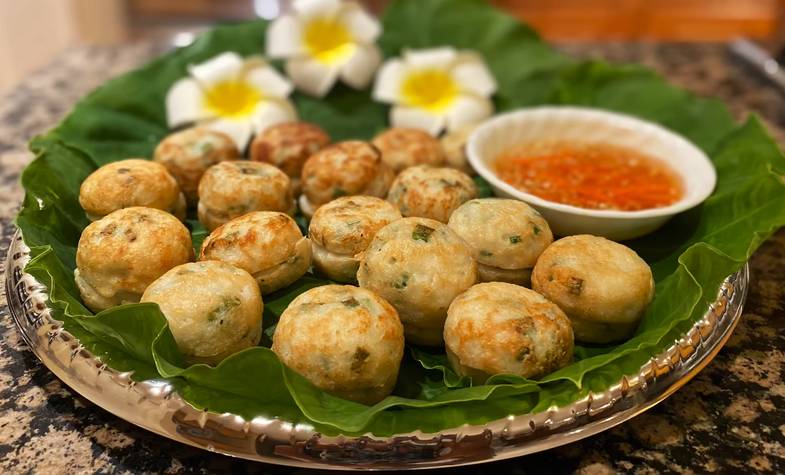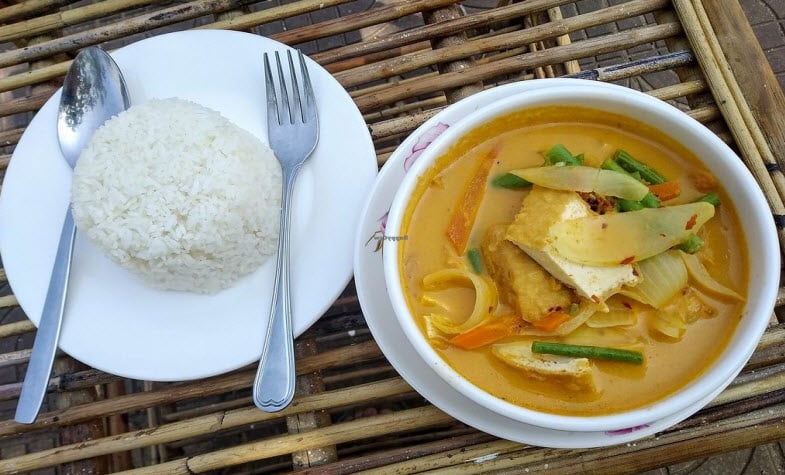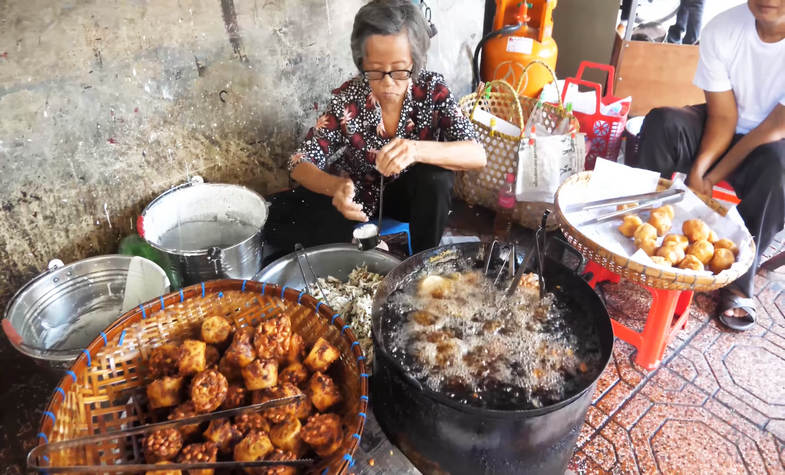A glimpse into Cambodian cuisine
Cambodian food is a delicious blend of traditional flavors and unique Southeast Asian flair. From the fragrant Amok, a signature fish curry, to the tantalizing sweet and sour Samlor Korko, each dish tells a story of Khmer culture. If you're a foodie, don't miss the chance to try these amazing dishes when you visit the land of temples!
The unique features of Cambodia food
Cambodian cuisine offers a subtle yet surprisingly distinct flavor profile, setting it apart from its neighbors like Thailand and Vietnam food. While Thai food is known for its fiery spice and Vietnamese cuisine for its light, fresh flavors, Cambodian food strikes a unique balance of sweet, salty, sour, and a hint of intriguing bitterness. Dishes like Amok, a steamed fish curry in banana leaves, and Bai Sach Chrouk, grilled pork with rice, showcase this gentle yet rich taste. The use of coconut milk, prahok (fermented fish paste), and traditional herbs adds depth without overwhelming the palate.

These distinctions stem from the ancient Khmer civilization and influences from India and China. Cambodia's tropical climate and abundant resources, from the plains and Mekong River to the Tonlé Sap Lake, create a diverse cuisine with rice as the staple, accompanied by freshwater fish, boiled vegetables, and distinctive fermented fish pastes. A traditional Khmer meal often features a harmonious balance of savory dishes, soups, and raw vegetables, ensuring nutritional and flavor equilibrium. This makes Cambodian food not only delicious but also a vivid reflection of the culture and lifestyle of its people.
A food lover’s guide to Cambodian food
-
Amok: This is a symbol of Cambodian food, offering a delicate flavor with a combination of fresh fish, creamy coconut milk, and kroeung – a signature Cambodian spice paste. The dish is steamed in banana leaves, creating a smooth, mousse-like texture infused with kaffir lime leaf aroma. When eaten, the creamy, sweet, and slightly spicy flavors blend together for an unforgettable culinary experience.
-
Bai Sach Chrouk: This is a popular Cambodian breakfast consisting of soft, fluffy white rice and fragrant grilled pork. The pork is marinated in coconut milk and garlic, then grilled over charcoal, creating a glossy caramel crust and a subtle sweet flavor. The dish is usually served with pickled vegetables for a crunchy sour taste and a light broth to balance the flavors.
-
Lok Lak: This is a flavorful stir-fried beef dish with a bold black pepper sauce, showing a slight French culinary influence while maintaining its Cambodian identity. Tender beef is carefully marinated and quickly stir-fried over high heat to retain its juiciness. The dish is served with fresh vegetables, a fried egg, and a lime-pepper dipping sauce, creating a harmonious blend of salty, sour, and spicy flavors.

-
Nom Banh Chok: Known as "Cambodian noodles," Nom Banh Chok is a favorite breakfast dish. Fresh rice noodles are served with a rich fish broth cooked with golden kroeung made from turmeric and lemongrass. When eaten, various raw vegetables such as long beans, banana blossoms, and bean sprouts are added, creating a refreshing and balanced flavor.
-
Samlor Korko: This is one of Cambodia's oldest soups, combining over 10 ingredients, including fish, pork, and various vegetables and fruits like unripe jackfruit. The broth is cooked with kroeung, creating a fragrant aroma of lemongrass, green peppercorns, and distinctive prahok (fermented fish paste). The soup has a rich, slightly spicy, and savory flavor, providing a warm and inviting feeling.
-
Khmer Red Curry: Unlike the fiery Thai curry, Khmer Red Curry has a mild creamy flavor from coconut milk, combined with chicken, sweet potatoes, and eggplant for a harmonious blend. The kroeung spices enhance the signature aroma, while the smooth broth soaks into every piece of meat. The dish is often served with French-style bread, an interesting fusion of Eastern and Western cuisine.
Vegetarian Cambodia food you’ll love
Cambodian cuisine isn't just about savory dishes; it also offers fantastic options for vegetarians. Samlor Korko – a vegetarian stew with young jackfruit, okra, and pumpkin – provides a naturally sweet, aromatic, and rich flavor. If you're looking for something light, don't miss Chive Cakes, crispy and chewy chive pancakes dipped in a tangy and spicy tamarind soy sauce that will tantalize your taste buds. These vegetarian dishes are not only delicious but also allow you to better appreciate the subtlety and balance of Cambodian food, making your culinary journey even more fulfilling!
Must-Try Street Food in Cambodia
If you're a street food enthusiast, Cambodian cuisine will definitely captivate you with its flavorful dishes. Num Pang – a Khmer-style baguette – features a crispy crust, savory grilled meat filling, fresh herbs, and a tantalizing sweet and sour sauce. Lort Cha – stir-fried rice noodles with eggs and bean sprouts – offers a rich, slightly spicy, and creamy flavor, best enjoyed with a fiery chili sauce. And don't forget to try Ang Dtray-Meuk, charcoal-grilled squid dipped in a lime-pepper salt, fresh and infused with a distinctive smoky aroma. Each dish embodies the essence of Cambodia, both delicious and providing insight into the vibrant street culture of the land of temples!

Tips for an unforgettable Cambodia Food adventure
-
Explore by Bike or Tuk-Tuk: Wandering through food markets, riverside eateries, or bustling street stalls will give you a closer look at the essence of Cambodian cuisine.
-
Enjoy a Khmer Family Meal: If you have the opportunity, join a meal with a local family to experience how they prepare and enjoy traditional dishes.
-
Dare to Try Insect Specialties: A trip to Cambodia isn't complete without trying crispy fried crickets, grilled spiders, or garlic-roasted scorpions – protein-rich and incredibly unique dishes!
-
Dine on a Boat at Tonlé Sap Lake: Sitting on a wooden boat in a floating village, enjoying fresh grilled fish with lime-pepper salt, and listening to stories about life on the river will surely be an unforgettable experience.

-
Discover Kampot Pepper Farms and Spice Gardens: See firsthand the process of growing world-famous Kampot pepper, or visit farms that grow lemongrass, turmeric, and kaffir lime leaves – essential ingredients in Khmer cuisine.
-
Dine in a Khmer-Style Restaurant: Some restaurants in Siem Reap and Phnom Penh recreate the Khmer royal atmosphere with delicately presented traditional cuisine, offering a dining experience fit for kings.
-
Try Local Beverages: Don't forget to sip on Teuk Ampil (tamarind juice), Sugarcane Juice, or enjoy palm wine, a distinctive Cambodian specialty.
Cambodian food is more than just dishes; it's a journey to discover the culture, people, and long-standing traditions. From rustic street food to refined specialties, Cambodian cuisine promises to captivate every food lover. If you want to experience new and authentic flavors, don't hesitate to plan a trip and savor them right in the land of temples! And don't forget to share your thoughts on these unique dishes!
Our tours you may like:
*** Travel Authentic Asia Company is your best choice for discovering the beauty of Southeast Asia. Our experienced and knowledgeable travel advisors are committed to helping you create a tailor-made tour and extraordinary experiences in this majestic region.
If you're looking for an authentic cultural experience, do not hesitate to contact Travel Authentic Asia to choose a Vietnam tour, Southeast Asia tour package or to customize your own style tour to South East Asia.

